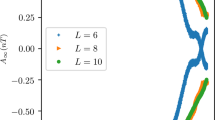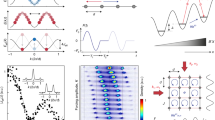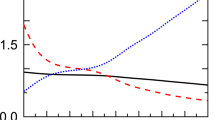Abstract
Periodically driven Floquet quantum systems could provide a promising platform to investigate novel physics out of equilibrium1, but the drive generically heats the system to a featureless infinite-temperature state2,3,4. Fortunately, for high driving frequency, the heat absorption rate has been theoretically predicted to be exponentially small, giving rise to a long-lived prethermal regime that exhibits all the intriguing properties of Floquet systems5,6,7,8. Here we experimentally observe Floquet prethermalization using NMR techniques and probe the heating rate. We first show the relaxation of a far-from-equilibrium initial state to a long-lived prethermal state, well described by a time-independent ‘prethermal’ Hamiltonian. By measuring the autocorrelation of this prethermal Hamiltonian we can further experimentally confirm the predicted exponentially slow heating rate. More strikingly, we find that, on the timescale at which the prethermal Hamiltonian picture breaks down, the Floquet system still possesses other quasiconservation laws. Our results demonstrate that it is possible to realize robust Floquet engineering, thus enabling the experimental observation of non-trivial Floquet phases of matter.
This is a preview of subscription content, access via your institution
Access options
Access Nature and 54 other Nature Portfolio journals
Get Nature+, our best-value online-access subscription
$29.99 / 30 days
cancel any time
Subscribe to this journal
Receive 12 print issues and online access
$209.00 per year
only $17.42 per issue
Buy this article
- Purchase on Springer Link
- Instant access to full article PDF
Prices may be subject to local taxes which are calculated during checkout



Similar content being viewed by others
Data availability
Source data and all other data that support the plots within this paper and other findings of this study are available from the corresponding author upon reasonable request.
References
Eisert, J., Friesdorf, M. & Gogolin, C. Quantum many-body systems out of equilibrium. Nat. Phys. 11, 124–130 (2015).
Lazarides, A., Das, A. & Moessner, R. Equilibrium states of generic quantum systems subject to periodic driving. Phys. Rev. E 90, 012110 (2014).
D’Alessio, L. & Rigol, M. Long-time behavior of isolated periodically driven interacting lattice systems. Phys. Rev. X 4, 041048 (2014).
Kim, H., Ikeda, T. N. & Huse, D. A. Testing whether all eigenstates obey the eigenstate thermalization hypothesis. Phys. Rev. E 90, 052105 (2014).
Abanin, D. A., De Roeck, W., Ho, W. W. & Huveneers, F. Effective Hamiltonians, prethermalization, and slow energy absorption in periodically driven many-body systems. Phys. Rev. B 95, 014112 (2017).
Abanin, D. A., De Roeck, W. & Huveneers, F. Exponentially slow heating in periodically driven many-body systems. Phys. Rev. Lett. 115, 256803 (2015).
Kuwahara, T., Mori, T. & Saito, K. Floquet–Magnus theory and generic transient dynamics in periodically driven many-body quantum systems. Ann. Phys. 367, 96–124 (2016).
Abanin, D., De Roeck, W., Ho, W. W. & Huveneers, F. A rigorous theory of many-body prethermalization for periodically driven and closed quantum systems. Commun. Math. Phys. 354, 809–827 (2017).
Gómez-León, A. & Platero, G. Floquet–Bloch theory and topology in periodically driven lattices. Phys. Rev. Lett. 110, 200403 (2013).
Lindner, N. H., Refael, G. & Galitski, V. Floquet topological insulator in semiconductor quantum wells. Nat. Phys. 7, 490–495 (2011).
Wang, Y., Steinberg, H., Jarillo-Herrero, P. & Gedik, N. Observation of Floquet–Bloch states on the surface of a topological insulator. Science 342, 453–457 (2013).
Eckardt, A., Weiss, C. & Holthaus, M. Superfluid–insulator transition in a periodically driven optical lattice. Phys. Rev. Lett. 95, 260404 (2005).
Tsuji, N., Oka, T., Werner, P. & Aoki, H. Dynamical band flipping in fermionic lattice systems: an ac-field-driven change of the interaction from repulsive to attractive. Phys. Rev. Lett. 106, 236401 (2011).
Görg, F. Enhancement and sign change of magnetic correlations in a driven quantum many-body system. Nature 553, 481–485 (2018).
Lloyd, S. Universal quantum simulators. Science 273, 1073–1078 (1996).
Childs, A. M., Maslov, D., Nam, Y., Ross, N. J. & Su, Y. Toward the first quantum simulation with quantum speedup. Proc. Natl Acad. Sci. USA 115, 9456–9461 (2018).
Choi, S. Observation of discrete time-crystalline order in a disordered dipolar many-body system. Nature 543, 221–225 (2017).
Zhang, J. Observation of a discrete time crystal. Nature 543, 217–220 (2017).
Bastidas, V. M., Emary, C., Regler, B. & Brandes, T. Nonequilibrium quantum phase transitions in the Dicke model. Phys. Rev. Lett. 108, 043003 (2012).
Wei, K. X., Ramanathan, C. & Cappellaro, P. Exploring localization in nuclear spin chains. Phys. Rev. Lett. 120, 070501 (2018).
Lazarides, A., Das, A. & Moessner, R. Fate of many-body localization under periodic driving. Phys. Rev. Lett. 115, 030402 (2015).
Ponte, P., Papić, Z., Huveneers, F. & Abanin, D. A. Many-body localization in periodically driven systems. Phys. Rev. Lett. 114, 140401 (2015).
Bordia, P., Lüschen, H., Schneider, U., Knap, M. & Bloch, I. Periodically driving a many-body localized quantum system. Nat. Phys. 13, 460–464 (2017).
Khemani, V., Lazarides, A., Moessner, R. & Sondhi, S. L. Phase structure of driven quantum systems. Phys. Rev. Lett. 116, 250401 (2016).
Heyl, M., Hauke, P. & Zoller, P. Quantum localization bounds Trotter errors in digital quantum simulation. Sci. Adv. 5, eaau8342 (2019).
Sieberer, L. M. Digital quantum simulation, Trotter errors, and quantum chaos of the kicked top. npj Quantum Inf. 5, 78 (2019).
Ji, K. & Fine, B. V. Suppression of heating in quantum spin clusters under periodic driving as a dynamic localization effect. Phys. Rev. Lett. 121, 050602 (2018).
D’Alessio, L. & Polkovnikov, A. Many-body energy localization transition in periodically driven systems. Ann. Phys. 333, 19–33 (2013).
Yin, C., Peng, P., Huang, X., Ramanathan, C. & Cappellaro, P. Prethermal quasiconserved observables in Floquet quantum systems. Preprint at https://arxiv.org/abs/2005.11150 (2020).
Else, D. V., Bauer, B. & Nayak, C. Prethermal phases of matter protected by time-translation symmetry. Phys. Rev. X 7, 011026 (2017).
Luitz, D. J., Moessner, R., Sondhi, S. L. & Khemani, V. Prethermalization without temperature. Phys. Rev. X 10, 021046 (2020).
Machado, F., Else, D. V., Kahanamoku-Meyer, G. D., Nayak, C. & Yao, N. Y. Long-range prethermal phases of nonequilibrium matter. Phys. Rev. X 10, 011043 (2020).
Herrmann, A., Murakami, Y., Eckstein, M. & Werner, P. Floquet prethermalization in the resonantly driven Hubbard model. Europhys. Lett. 120, 57001 (2018).
Bukov, M., Heyl, M., Huse, D. A. & Polkovnikov, A. Heating and many-body resonances in a periodically driven two-band system. Phys. Rev. B 93, 155132 (2016).
Mallayya, K. & Rigol, M. Heating rates in periodically driven strongly interacting quantum many-body systems. Phys. Rev. Lett. 123, 240603 (2019).
Goldman, M. Spin Temperature and NMR in Solids (Clarendon, 1970).
Wei, K. X. Emergent prethermalization signatures in out-of-time ordered correlations. Phys. Rev. Lett. 123, 090605 (2019).
Jeener, J. & Broekaert, P. Nuclear magnetic resonance in solids: thermodynamic effects of a pair of rf pulses. Phys. Rev. 157, 232–240 (1967).
Rubio-Abadal, A. Floquet prethermalization in a Bose–Hubbard system. Phys. Rev. X 10, 021044 (2020).
Ramanathan, C., Cappellaro, P., Viola, L. & Cory, D. G. Experimental characterization of coherent magnetization transport in a one-dimensional spin system. New J. Phys. 13, 103015 (2011).
Magnus, W. On the exponential solution of differential equations for a linear operator. Commun. Pure Appl. Math. 7, 649–673 (1954).
Blanes, S., Casas, F., Oteo, J. & Ros, J. The Magnus expansion and some of its applications. Phys. Rep. 470, 151–238 (2009).
Bukov, M., D’Alessio, L. & Polkovnikov, A. Universal high-frequency behavior of periodically driven systems: from dynamical stabilization to Floquet engineering. Adv. Phys. 64, 139–226 (2015).
Yan, F. Rotating-frame relaxation as a noise spectrum analyser of a superconducting qubit undergoing driven evolution. Nat. Commun. 4, 2337 (2013).
Laucht, A. A dressed spin qubit in silicon. Nat. Nanotechnol. 12, 61–66 (2017).
Golter, D. A., Baldwin, T. K. & Wang, H. Protecting a solid-state spin from decoherence using dressed spin states. Phys. Rev. Lett. 113, 237601 (2014).
Timoney, N. Quantum gates and memory using microwave-dressed states. Nature 476, 185–188 (2011).
Munowitz, M. & Pines, A. in Advances in Chemical Physics Vol. 66 (eds Prigogine, I. & Rice, S.) 1–152 (Wiley, 1975).
Gärttner, M., Hauke, P. & Rey, A. M. Relating out-of-time-order correlations to entanglement via multiple-quantum coherences. Phys. Rev. Lett. 120, 040402 (2018).
Acknowledgements
We thank H. Zhou, W.-J. Zhang and Z. Li for discussion. This work was supported in part by the National Science Foundation under grants no. PHY1734011, no. PHY1915218 and no. OIA-1921199.
Author information
Authors and Affiliations
Contributions
P.P. performed the experiments. P.P. and C.Y. analysed the data and developed the theoretical modelling. P.C. supervised the project. All authors discussed the results and contributed to the manuscript.
Corresponding authors
Ethics declarations
Competing interests
The authors declare no competing interests.
Additional information
Peer review information Nature Physics thanks the anonymous reviewers for their contribution to the peer review of this work.
Publisher’s note Springer Nature remains neutral with regard to jurisdictional claims in published maps and institutional affiliations.
Extended data
Extended Data Fig. 1 Background decay dependence on Jτ.
Decay rate of 〈Y(n)Y〉 (blue) and 〈Dy(n)Dy〉 (green) under engineered dipolar Hamiltonian JDy as a function of Jτ. The range of Jτ studied was obtained by varying the scaling u (Supplementary Information) from 0.098 to 0.646, while keeping fixed τ = 120μs. In the inset, we compare the background decay rates with the Floquet decay rates (dashed lines).
Extended Data Fig. 2 Signatures of a robust quasiconserved quantity for the kicked dipolar model.
We numerically evaluate the expansion of the quasiconserved quantity Dpre and plot the norm of each term (normalized by L2L) as a function of the expansion order m, for various hτ = Jτ. Jτ varies from 0 (light colors) to 2 (dark colors) in steps of 0.2. (a) Infidelity 1 − 〈Dpre(∞)Dpre〉/〈DpreDpre〉 of the infinite-time averaged Dpre as a function of the order, m, for various hτ = Jτ. Jτ varies from 0 (light colors) to 2 (dark colors) in steps of 0.2. (b) Infidelity 1 − 〈Hpre(∞)Hpre〉/〈HpreHpre〉 of the infinite-time averaged prethermal Hamiltonian Hpre as a function of the order, m, for various hτ = Jτ. L = 12 was used in (a-b). The normalized autocorrelation of Hpre converges to 1 in a smaller parameter range (Jτ ≲ 1) than Dpre (Jτ ≲ 1.6) (c) Fidelities of the two conserved quantities (〈Hpre(∞)Hpre〉/〈HpreHpre〉 and 〈Dpre(∞)Dpre〉/〈DpreDpre〉) evaluated to 7th order as a function of hτ for three different system sizes. The fidelities show a notable drop when L is increased from 8 to 12 at Jτ ≳ 1.8 for Dpre and Jτ ≳ 1.2 for Hpre, again indicating that Dpre is more robust than Hpre.
Supplementary information
Supplementary Information
Supplementary Figs. 1–4 and Discussion.
Rights and permissions
About this article
Cite this article
Peng, P., Yin, C., Huang, X. et al. Floquet prethermalization in dipolar spin chains. Nat. Phys. 17, 444–447 (2021). https://doi.org/10.1038/s41567-020-01120-z
Received:
Accepted:
Published:
Issue Date:
DOI: https://doi.org/10.1038/s41567-020-01120-z
This article is cited by
-
Stalled response near thermal equilibrium in periodically driven systems
Nature Communications (2024)
-
Universal hypothesis of autocorrelation function from Krylov complexity
Quantum Frontiers (2024)
-
Critical prethermal discrete time crystal created by two-frequency driving
Nature Physics (2023)
-
Floquet space exploration for the dual-dressing of a qubit
Scientific Reports (2023)
-
Noisy intermediate-scale quantum computers
Frontiers of Physics (2023)



